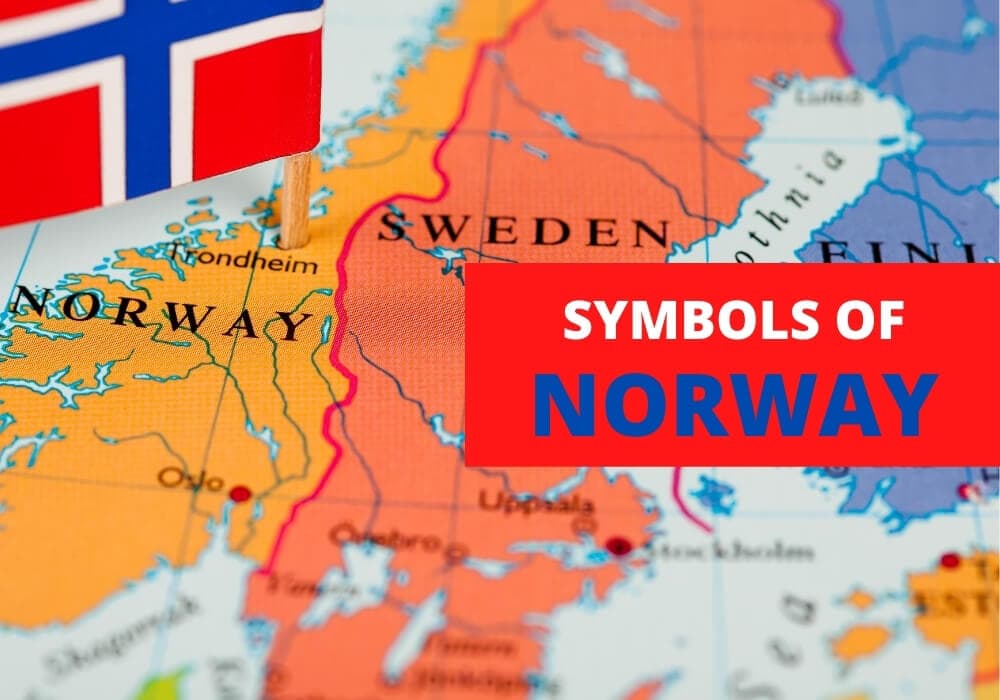
Table of Contents
Norway, officially the Kingdom of Norway, lies in the northern part of the Scandinavian Peninsula. Known for its egalitarian ideals and outstanding welfare system, Norway consistently tops the World Happiness Report.
The country boasts a long and rich history, rooted in captivating Norse mythology. Its landscapes, ranging from fjords to glaciers and mountains, rank among the world’s most breathtaking. For visitors, Norway’s blend of natural beauty and cultural richness leaves a lasting impression.
Many official and unofficial symbols represent Norway, reflecting its rich culture and stunning landscapes. Let’s explore these popular Norwegian symbols and their meanings.
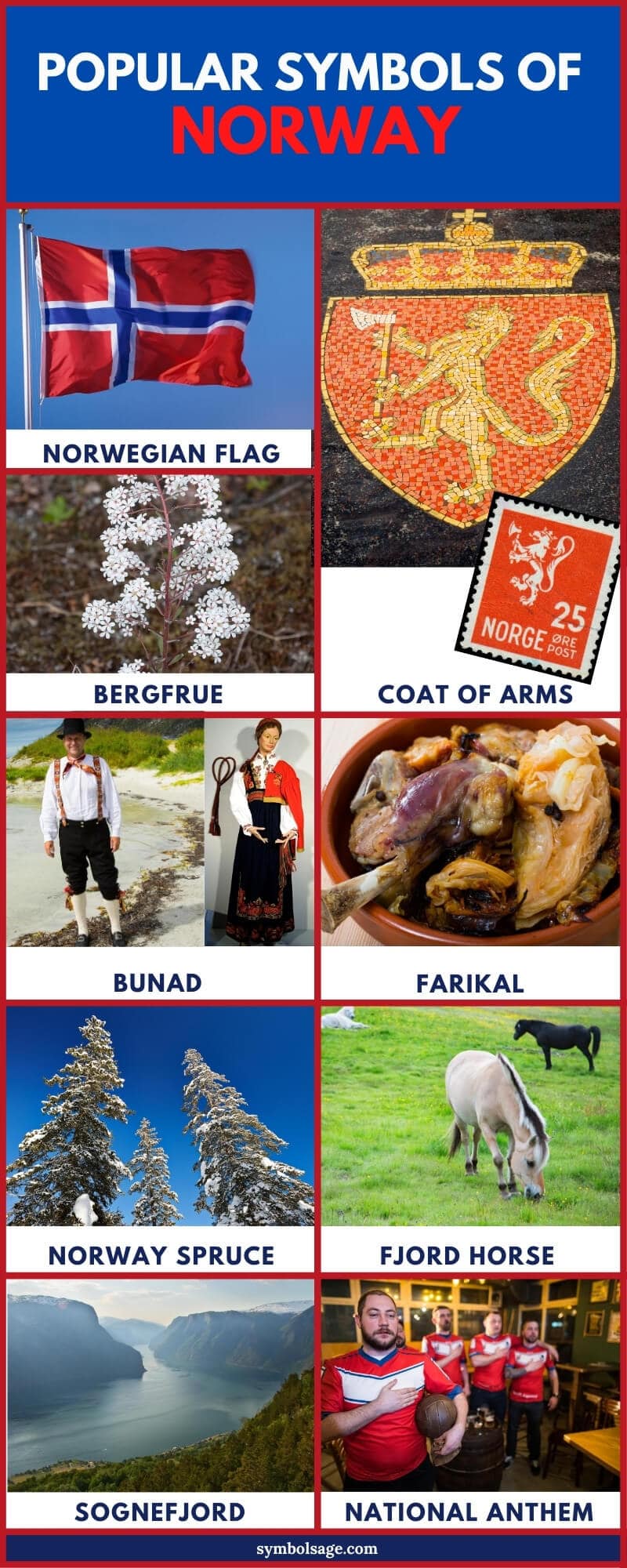
- National Day: 17th of May – Constitution Day in Norway
- National Anthem: Ja, vi elsker dette landet (Yes, we love this country)
- National Currency: Norwegian krone
- National Colors: Red, white and indigo blue
- National Tree: Norway spruce
- National Animal: White-throaded dipper (bird) and the Fjord horse
- National Dish: Farikal
- National Flower: Bergfrue
- National Fruit: Apples
- National Dress: Bunad
The Norwegian Flag
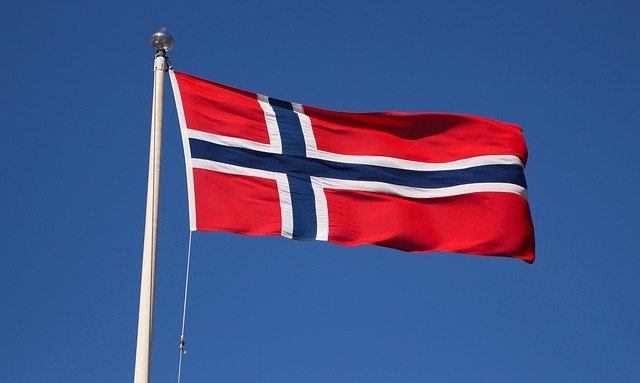
Norway’s national flag features a red field with an indigo blue Scandinavian cross, bordered in white, that extends to the flag’s edges. The cross’s vertical line sits closer to the hoist side, resembling the Danish flag’s design.
Fredrik Meltzer designed the current flag in 1821. At that time, the flag committee proposed a two-color design, red and white, but Meltzer argued it was too similar to Denmark’s flag. He suggested the tricolor design, which was then approved and has been Norway’s national flag ever since.
The Norwegian flag’s colors represent the country’s independence and freedom. The indigo blue cross signifies Norway’s union with Sweden and its historical ties with Denmark. It also reflects Christianity, a common symbol in Nordic countries.
The Coat of Arms of Norway
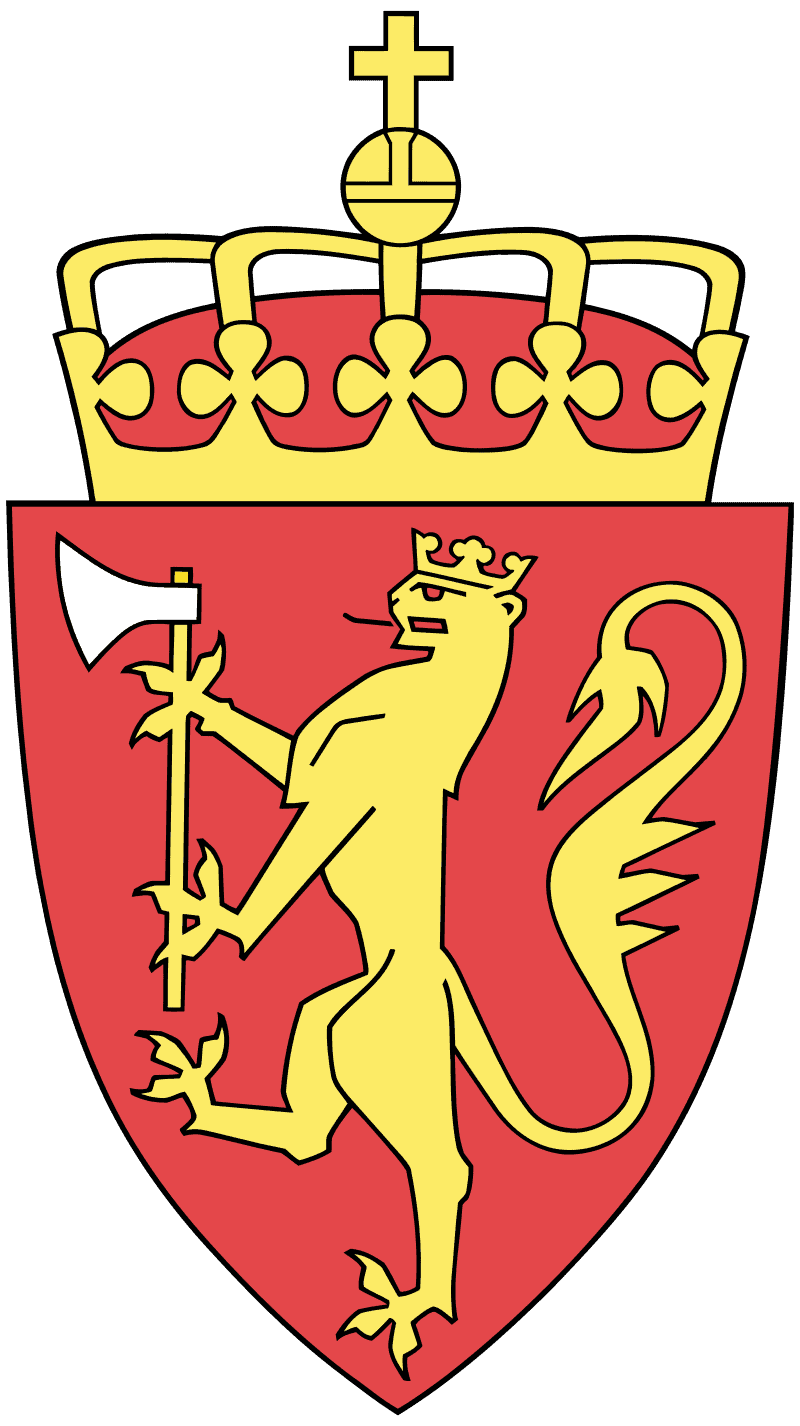
The Norwegian Coat of Arms, representing both King Harald V and the kingdom, features a golden lion on a red shield, holding an axe with a silver blade, and a golden crown above it. Recognized as one of Europe’s oldest coats of arms, it serves as the symbol of the Parliament, Supreme Court, and the King, the three powers outlined in the Constitution.
Various regional, national, and local authorities, including County Governors and courts, also use it. The coat of arms forms the basis of the Royal Standard, the monarch’s flag.
Originating in the 13th century, the coat of arms evolved from the Sverre dynasty’s arms. Initially, it displayed only the golden lion on a red shield, but over time, designers added elements like the silver axe. The current design, adopted in 1992, remains unchanged.
The National Anthem of Norway
“Ja, vi elsker dette landet,” meaning “Yes, we love this country” in English, is not just any song – it’s Norway’s national anthem. The famous Norwegian poet Bjornstjerne Bjornson wrote the lyrics, and Rikard Nordraak composed the music.
Originally a patriotic song, it slowly became more popular than “Sonner av Norge” (“Sons of Norway”), the old go-to national anthem. For a long time, Norway didn’t officially pick a national anthem, using a few different ones. But in 2019, “Ja, vi elsker dette landet” officially took that spot.
This was a big deal for Norway, really showing off what the country stands for and cherishes. The anthem’s words and tune paint a picture of Norway’s stunning landscapes, rich history, and the spirit of its people, perfectly capturing what Norway is all about.
The Bunad
Norway’s national costume, the ‘bunad,’ is a traditional folk outfit popular among women but also worn by men. It’s a smart, colorful costume, usually made of wool and decked out with buttons, jewelry, and metal buckles. The men’s bunad includes knee-length trousers, an embroidered linen shirt, a jacket, a vest, shoes, stockings, and a hat. They’re less flashy than the women’s versions but still noble-looking and elegant.
Women’s bunads stand out with lots of embroidery that ties the whole outfit together. The embroidery’s color can hint at things like marital status – white for single, multicolored for married, and black for widows.
The bunad is a big deal in Norwegian culture, symbolizing patriotism. It’s now one of the most famous traditional costumes worldwide. People wear bunads for special events and on Norway’s Constitution Day, you’ll see thousands of Norwegians hitting the streets in their colorful bunads.
Farikal
Farikal, or mutton in cabbage, is a classic Norwegian dish made by boiling mutton, cabbage, whole black peppercorns, and salt for several hours. It’s ready when the mutton gets very tender and just falls off the bone. You usually eat it with boiled potatoes. While people traditionally cook it in autumn, it’s a year-round favorite and has been Norway’s national dish since the 1970s.
Norwegians love Farikal because its ingredients really show off Norway’s natural abundance. Each part of the dish is like a little piece of Norway. It’s been a popular meal in Norway for generations, especially in fall when cabbage and lamb are in season.
Bergfrue
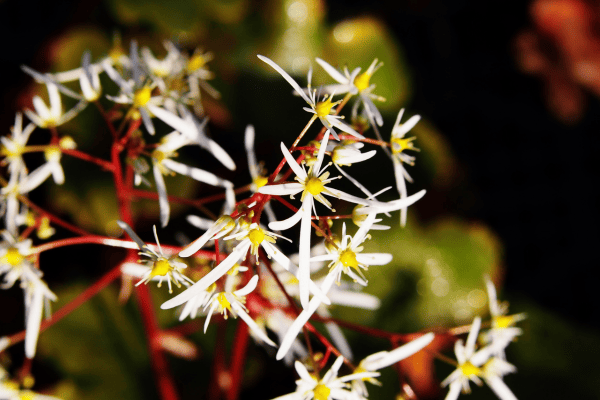
Bergfrue, or Saxifraga cotyledon, is a gorgeous perennial flower from Europe’s mountains. It stands out with its big, flat leaf rosettes that are broad, strap-shaped, and have fine teeth around the edges. With over 440 types, every Bergfrue is unique. They mostly bloom in white, but you can also find them in pink, yellow, and red, brightening up mountain areas.
Growing Bergfrue from seeds is pretty straightforward, and it’s great at self-sowing, keeping itself around in the wild. Norway picked it as its national flower in 1935, a solid choice because it’s all about affection, passion, and devotion.
These qualities fit well with what Norway’s all about. Bergfrue’s toughness and its knack for surviving in tough mountain spots make it a spot-on symbol for Norway’s stunning, rugged scenery.
Norway Spruce
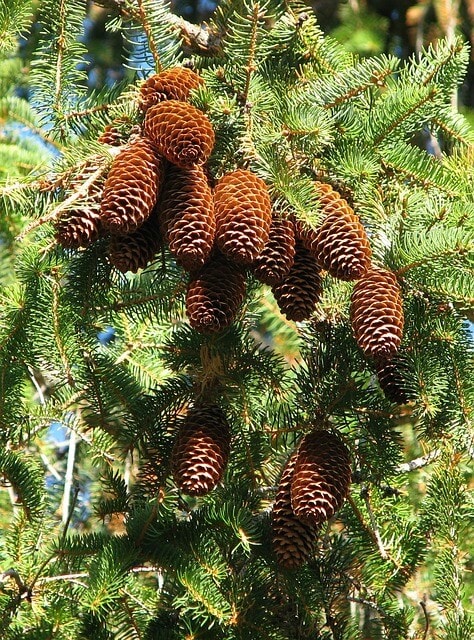
The Norway spruce, or Picea abies, is Norway’s national tree and grows across central, northern, and eastern Europe. This big evergreen tree is known for its branches that hang downwards. It’s a popular choice for Christmas trees around the world. When young, it grows quickly, but this slows down as it ages.
People plant the Norway spruce a lot for its strong and flexible wood, often called whitewood or deal, and it’s also used in making paper. Every Christmas, Oslo sends a beautiful Norway spruce to London’s Trafalgar Square, Washington D.C., and Edinburgh. This tradition is a thank-you gesture for the support these countries gave Norway during World War II.
Halling
Halling, a lively folk dance, is a hit in Norway’s rural areas, especially with young guys at events like parties and weddings. It’s a fast-paced, acrobatic dance that tests the dancer’s strength and grace. Each step shows off the dancer’s agility.
The dance gets its name from the Hallingdal region and usually, it’s a solo act. But in Western Norway, dancing in pairs is more the norm. Halling used to be mostly for guys, but nowadays, lots of girls are getting into it and they’re nailing it just as well as the guys.
More than just fun, Halling is a big part of Norway’s culture, showing off the heritage and vibe of the rural areas. It’s key in keeping Norwegian folk traditions alive, uniting communities with its high-energy and engaging moves.
Fjord Horse
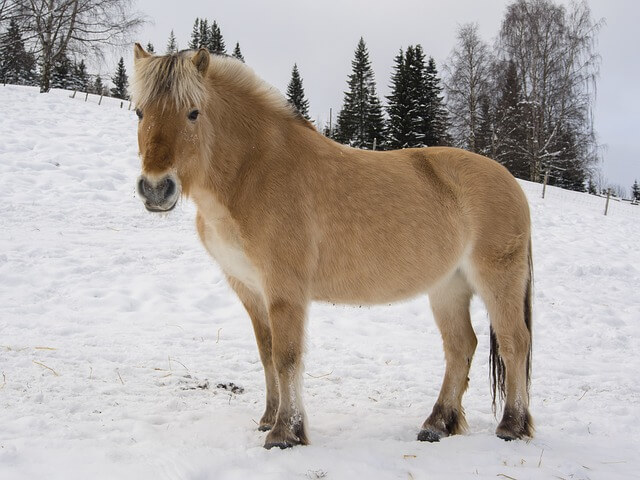
The Fjord horse, a small yet strong horse breed, comes from Western Norway’s rocky mountains. All Fjord horses have a dun color, making this one of the world’s oldest horse breeds. They’ve been farm horses in Norway for centuries, known for their great temperament and unique look.
These horses have thick, heavy manes that people usually trim into a crescent shape, about 5-10 centimeters high, standing straight up. This style makes grooming easier and shows off their strong neck and the dorsal stripe, a common feature in dun horses.
Fjord horses have been around in Norway since the last ice age ended. Archaeological digs show they’ve been bred for around 2000 years, always purebred, with no mixing from other horse types. Today, they’re really popular in therapeutic and riding schools in Norway. Their calm and easy-going nature makes them a hit with kids and folks with disabilities.
Sognefjord
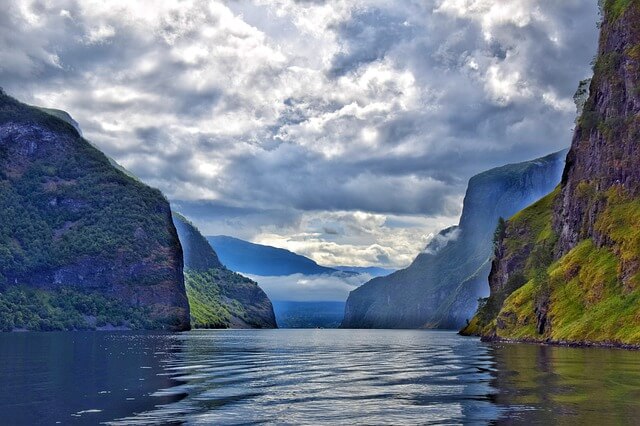
Sognefjord, also known as Sognefjorden, holds the title as Norway’s deepest and biggest fjord, stretching 205 kilometers inland from the ocean. It reaches a maximum depth of about 4,291 feet below sea level and runs through several municipalities.
Famous for its stunning scenery and untouched nature, Sognefjord attracts loads of tourists every summer, playing a big part in the local economy. The area offers unique cultural spots and lots of fun activities for tourists.
There’s a plan in the works to build a road across the fjord, using a tube submerged in the water and anchored to floats. This road would let people cross over without having to deal with storms on the surface. But it’s still up in the air whether this plan will actually happen.
Sognefjord is one of Norway’s most incredible landmarks. National Geographic Traveler Magazine even called it the ‘world’s most iconic destination’.
Wrapping Up
Norway’s symbols truly capture the country’s gorgeous nature, rich culture, and strong spirit. Each one tells Norway’s story in its own way, showing off what makes Norway special and memorable to the world.








